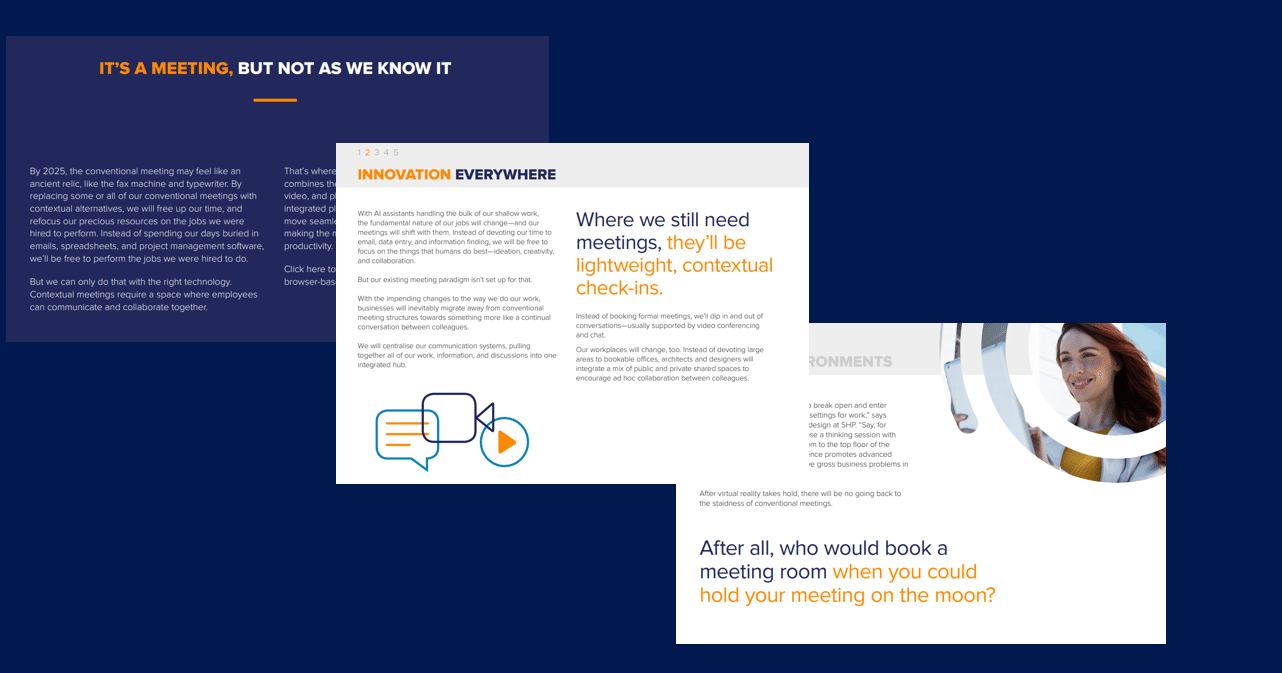The business meeting as we know it has an expiry date. In recent years, in person, prescheduled, and time-boxed meetings have grown a reputation for being a time-costly and often unproductive convention. The subject of great frustration for employees and arguably a great waste of resources for employers, unnecessary or badly organised meetings are said to cost UK businesses more than £191B a year. The way we work is clearly changing, and traditional time-draining meetings are coming into question.
One solution is to replace many of our conventional meetings with contextual alternatives. Contextual meetings take place within the digital collaboration space a team uses. Instead of moving to a physical office (something many of us haven’t done in a while now) employees hold these meetings where they’re already working.
As work culture and technology continue to mature, there may be less space for conventional meetings. They’re inflexible, resource-intensive, and don’t complement the way many contemporary organisations operate. But the disruption of conventional meetings is just the start. Many experts predict that workplaces of the future will seem entirely alien to contemporary workers.
Technologies, ideas, and philosophies that don’t necessarily exist yet will guide the development of both the work we do and the spaces in which we do it. But that doesn’t mean we can’t identify trends and make predictions.
Personal assistants for everyone
According to productivity expert Cal Newport, people have forgotten how to work in long, uninterrupted, cognitively demanding stretches of deep concentration, which he calls deep work. Instead, we fill our days with easy, administrative tasks he categorises as shallow work. Newport believes that AI holds the answer to combating the proliferation of productivity-sapping shallow work. He claims that digital assistants will shoulder most of these menial tasks, leaving us free to concentrate on cognitively demanding work.
“[I]t’s gonna be like you have your own presidential Chief of Staff,” Newport told Dropbox. “Everyone has their own agent, and the agents talk to each other. So, when you come in, it can say, ‘I’m talking to other people’s AI on your behalf.’ And Newport’s prediction might become reality sooner than you think. “The technology is here,” explained Michele Pini, Chief Technology Officer at AI company iGenius, “but there are two things separating us from an AI-augmented future: AI training and human trust.”

Innovation everywhere
With AI assistants handling shallow work, the fundamental nature of our jobs will change—and our meetings will shift with them. Instead of devoting our time to email, data entry, and information finding, we will be free to focus on the things that humans do best—ideation, creativity, and collaboration.
But our existing meeting paradigm isn’t set up for that.
With the impending changes to the way we do our work, businesses will inevitably migrate away from conventional meeting structures towards something more like a continual conversation between colleagues. We will centralise our communication systems, pulling together all our work, information, and discussions into one integrated hub.
Virtual and sensory experiences
Virtual reality (VR) technology has been around for decades, but until very recently it’s been prohibitively expensive for all but a few niche applications. However, in the last few years, a handful of technology companies have released headsets at a fraction of their original price.
As the cost of virtual reality equipment continues to tumble, the technology will enter the professional sphere and revolutionise how we approach meetings and collaborative work in general.
Experts predict that businesses will initially use VR to create a virtual mirror of physical offices. By implementing virtual versions of real places, remote team members can interact in a “real” office, and e-commerce customers can browse products in a “real” store.
“These virtual rooms will begin to break open and enter diverse and creatively engaging settings for work,” says Brady Mick, director of strategic design at SHP. “Say, for example, that you want to organise a thinking session with your teammates, so you invite them to the top floor of the Burj Khalifa. The sensory experience promotes advanced thinking among the group to solve gross business problems in innovative ways.” After virtual reality takes hold, there will be no going back to the staidness of conventional meetings.
When will we see the demise of the conventional meeting?
By 2025, the conventional meeting may feel like an ancient relic, like the fax machine and typewriter. By replacing some or all our conventional meetings with contextual alternatives, we will free up our time, and refocus our precious resources on the jobs we were hired to perform. Instead of spending our days buried in emails, spreadsheets, and project management software, we’ll be free to perform the jobs we were hired to do. But we can only do that with the right technology. Contextual meetings require a space where employees can communicate and collaborate.
Originally published Feb 12, 2021, updated Feb 16, 2021

